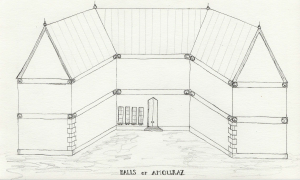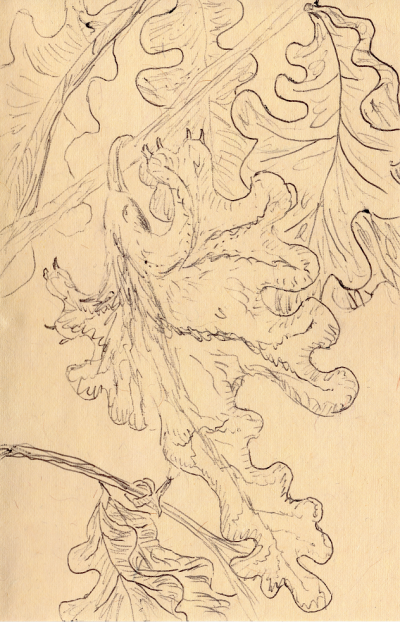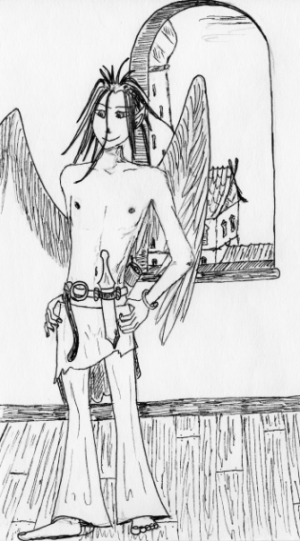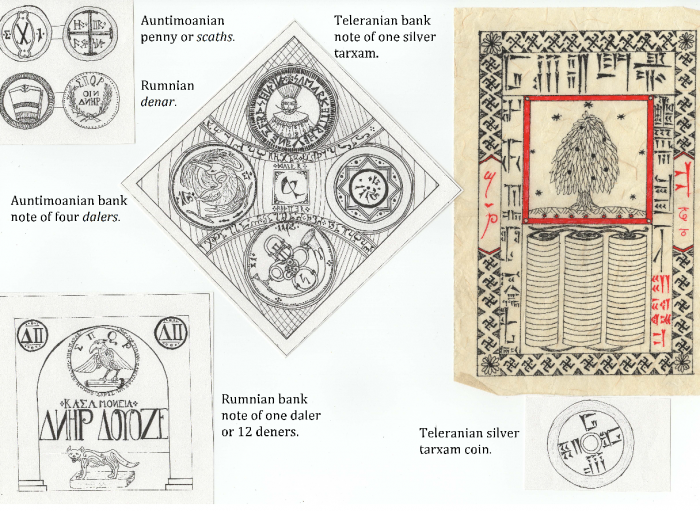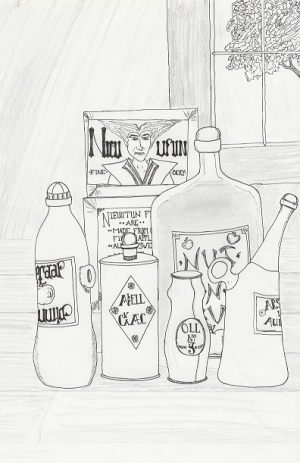The World - A Miscellany
Following are some short articles taken from A Companion Guide to the World.
The Great Road passes through many Daine lands, and all the Daine that live along it are friendly to traders and many offer refreshment at their hostelries and caravansaries. The Great Road be of immense age and uncertain construction. It is said to have been built by the Gods, or some race that lived in Asia after they departed. It traverses the whole of Asia and Hespera from the Iconian city of Pylycundas and thence into the untravelled lands of the Uttermost West. Regardless of its origins, it has a great virtue set upon it; for although no one tends the Road, it be always in good repair, broad and smooth. Leaves of the Fall and snows of Winter, no matter how deep, are in some way removed from the Road, or else never fall deeply upon it. Though other dangers and death may befall travellers along its immeasurable distances, no one ever falls into pits or mudholes and no one ever loses it after the fashion of so many other roads that dwindle and fade.
It is generally thought that the Halls were named for an early king of Auntimoany, but in reality, the word is derived from the Rumnian term immourezar or walling a person up into an inescapable cell.
Most cells are cramped, allowing for no more than enough room to lie down. Some prisoners, generally those of noble birth or wealth, are afforded slightly more commodious accomodations. Their cells might be eight foot by four and contain a chair and small table and perhaps a cot with blankets.
So effective was the Hall at Auntimoany that in 1599 one was built in Hoopelle, a lovely brick and stone structure with a park surrounding. Known as the Halls of Penitence, it soon gained a fearful reputation among the city's Daine population as many were shut up in its walls with no hope of escape or liberation as there often was in the City Gaol.
The Heredescopion is a rather interesting Device. Invented by Victorious Carpocrates of Alixaundria (in the East), it is a thaumological device that allows the user to see images of his descendants. In shape, it is a rectangular oaken box with curious round brass dials along the lower edge; in the centre is a large and slightly luminous crystal porthole that shines almost with an iridescent silvery sheen. It takes great will and concentration to use a heredscopion, and few can glimpse more than scattered and grainy images of people one does know, though a couple users have seen themselves, much older, reflected in the crystal viewport along with what appear to be young descendants.
One of the three devices crafted by Carpocrates was given to the Emperor of Hoopelle in 1666 by the Archon of Romishcalia as a Christmas gift. The emperor was said to have been rather afraid to use it and placed it in the Mathom until prodded into using it by the empress in 1670. It showed only a cold and bleak desert landscape devoid of any people. Thinking at first that he wasn't concentrating hard enough on his descendants, he became increasingly consumed with the visions of bleak and deserted lands. This so infuriated that emperor that in 1671 he sent assassins to murder the Archon in his bed. A scandal resulted, but the emperor continued to obsess over the dark crystal.
The Alarian Invasion of 1672, which toppled the old Empire of Hoopelle, put an end to both the emperor and his vain scrying for images of progeny. It is said that the Hoopellish heredscopion still rests in the ruins of the Palace where the empror last gazed into its enticing and murky depths. The whereabouts of the other two exemplars are unknown to the Wise, though it is entirely possible that at least one ended up being transported to Auntimoany along with other spoils of the invading armies.
Ankanic Fire is the name given to the unimaginably hot and semimolten metals and rocks that Gnomes and Dwarrows aver flow around the deepest parts of Gea. Here among the Pillars of the World dwell beings who not only uphold the solid rocks of the continents and islands of the Middle World, but literally inhabit a world that would burn and incinerate any being of the Middle World unfortunate enough to make even a brief visit.
Our best views into the world of these beings seems to be during volcanic eruptions, when the Ankanic Fires spew from the depths of the world and for a time flow unchecked across the face of the world until they cool and solidify into solid rock.
The heat of Ankanic Fire is so intollerably powerful that the very air around it is burned. Whereas normal fire can be used to cook meat or warm one on a cold day, and certain fakirs can even pass their hands through it or walk across hot coals with no harm, the power of Ankanic Fire consumes flesh and burns away all living things, leaving nothing more than a smudge of ash on the glowing and flowing surface of the living rock. Should the power of Ankanic Fire be channelled by an earth-magic wizard, it would instantly incinerate and vaporise anything that stands in its way and is not shielded with the most potent of shields.
It is said that [dragons] breathe something akin to the Ankanic Fire, for their breath is burning hot and only the most potent of shields may guard the intrepid knight that seeks after a dragon's treasure hoard. Such was the fabled Dalconne Shield, which absorbed the heats and vapours of dragonsbreath.
Yet unwise would be the knight who relied on even a whole suit of armour made of such stuff, for the Ankanic Fire is much more potent than even the strongest of dragons' breath. Even if the armour could long withstand the raging inferno, the knight himself would be roasted alive and his skull would burst from the raging boiling of his brains and his eyes would explode and be burnt to cinders and all that would be left is a smear of ashy powder. Eventually, even armour made of the same stuff as the fabled shield would melt into the incandescent rock around it.
Each wing has four short stubby claws that allow it to dig and burrow in the earth, or into rotten bark and wood to seek for burrowing insects and to crack open eggs; its hooked beak allows it to dangle from branch or twig while at rest, nestled safely among the rustling leaves of the tree. Its feathers are small, and many, especially upon its back, are almost hairlike. Its bony tail is long and supports a broad flat plate of small feathers. Although turonayan can fly short distances, it rarely does more than hurtle itself up into the low branches of a nearby tree, or else glide and flap from one tree to its neighbour.
The turonayan is, at the most, about two and a half palms long, inclusive of its curved beak. It is interesting to note, regarding its wing-claws, that the two pairs of claws may be manipulated independently of the other, but only in pairs: the claws may not be moved independently like our fingers because the two sets of digits had become, in ancient times, fused into one but retaining the distinct terminal phalanges. This does not hamper durono-bird in any way, however, since it is able to fold over its medial pairs of claws, much the way Daine or Men may fold their thumbs against their palms & fingers. This allows durono-bird to grasp small objects like nuts or eggs or baby squirrels.
The song of the Turonoyan is a kind of melancholic four note tune.
The Big Red Book of Regenreck was composed in the early 10th century by an unknown Avantimannish compiler. It consists of traditional old stories about the nature, adventures and fates of the Teutonic gods. The term comes from an old word, regenrecko, itself composed of recko: end, begining, destiny, origin and regeno: the gods, powers, archons, or rulers of the world. One of the curiouser facts about the End of All Things is that it seems the fates of whole worlds rests upon the activity of the Seven Squirrels of Regenreck.
The Red Book is presently kept in the royal library at Codeis of Harunn. The history of the Red Book seems to have brought it first to Hoopelle some time after that empire annexed Auntimoany. Then, after old Hoopelle fell in 1672, the Book was lost to the ken of the Wise until the mid-1700s when it appeared in a waggon boot sale in Codeis. It was recognised by the royal librarian and bought for the grand sum of 17 shillings. Auntimoanian diplomats have sought for the book's return several times over the years, but some excuse inevitably arises to prevent its return.
Opera The Rum and the Auntimoanians have taken to opera most fervently of all. The great House of Opera is a veritable temple to the opulent art, and was constructed to house the greatest orchestra in the world. If there's a big orchestra anywhere, they'll double its size. If there's a new and unusual instrument, they'll buy four and damn all if anyone can play the things. It houses the largest organ/calliope/flame thrower on the continent (though by imperial decree, they can't use the flame thrower anymore on account of the Empress's Mishap); and together they provide a rich (and occasionally dangerous) music to accompany the works of the greatest operatic geniuses in history: Wandell, Muckingham, Pardee, Fognardt, Qalpart & Suleyman, and many more.
They take on all the great themes of literature and history and turn em into operatic extravaganzas. Of course, there's the famous "Sack of Pylycundas", during which the Empress's featherd hat accidentally caught fire. Of course, the hat was a good sixteen feet tall or so, and on top of a four foot tall wig, she was never in any real danger; but she did run screaming from the theatre, so everyone had a grand time all the same.
Ancient thematic works like "Ulysses at Home and Abroad" and "Dido and Aeneas Do Rome"; romantic works like "The Nuptials of Picario" and "My Love Lies Bleeding"; comic works like "My Love Lies Bleeding (or, Oh Where Oh Where Has the Time Gone?)" and "The Brothers Grimme their Parade of Glee"; serious works like "Pharaoh's Daughter". All of them come to life for adoring audiences on the stage of the House of Opera!
Gnomic Music Historically, Gnomes and their music have been very little known or appreciated outside their homelands. It is not until the late 18th century that their music became well known. Miners and spelunckers working in the deeps of the Whythywindle and Arnal Mountains are said to have heard the music of the Gnomes, and it is from such accounts recorded during the 17th and 18th centuries that their musical traditions came to the attention of scholars in the Eastlands. It is said to be at once both lovely and somewhat jarring, as if two competing musics were craftily woven together and set as rivals. Certainly the music of Tsuutam served to break open the world of Gnomic music to a wider audience in the century following.
Gnomic music is typically divided into three broad categories: Epic, Folkloristic and Court musics, the latter of which is best known and understood among Men. The former two require a knowlege of the local language, and non-Gnomes as a rule do not know more than a couple words of any Gnomic language.
Gnomic Music refers in particular to the influence of this music of the Underworld upon the musicological sensibilities and tastes of Eastlanders. In particular, the use of tuned percussion insturments and the evolution of small orchestras in which a keyboard instrument, such as the exackier, is the focus rather than massed woodwind instruments. The classical orchestra for playing Gnomic court music consists of five to seven musicians. The principal plays upon the shaqtar, a kind of celesta or exackier and is responsible for the melodic and harmonic parts of the music. A second often plays upon the quntal, a kind of large lute and provides a reinforcement of the shaqtar's melody. Sometimes, the second will switch and reinforce the bass line and harmony. The other players share playing upon racks of tuned chimes, bells, gongs, wood blocks, tongue drums, drone pipes and the like instruments. The choice of drones and bells and chimes is determined by the tonality of the piece.
There are several characteristic dances of the court music. The tsarqan, or "courtly dance" is perhaps the best known, especially on account of Tsuutam's efforts during the 19th century. It is a social dance and may be danced by as many as 24 couples divided into two sides. Tsarqans are often danced in a set of three contrasting movements having different metres and different series of dance steps. Court dances tend to be slow to moderate of tempo and the dancers make use as much of elegant arm and upper body movement as they do of footwork. Below, you'll find examples of several kinds of musics heard in the Eastlands.
Traditionally, a single story was painted and published in a single volume; anymore it has become popular to serialise much longer and more intricate stories and place one or two episodes of several stories into a smaller volume. This way, a girl's collection of mancalio stories could span several dozens of volumes, each of which contains a chapter of two or three popular stories.
Mancalio are generally printed on cheap paper, though some special editions might be made using better quality stuff. Such works are made with engraved plates, and so avoid the Monsters Under Thy Bedde! phenomenon.
Mechanike Poetastro -- Sussuros's famous Clockwork Poet, or Mekhanike Poetastro, is a spectacular failure as far as producing lofty poetry is concerned. The mechanism is composed of a bronze plated wooden case which houses several drums upon which subjects, objects, verbs and phrases are inscribed and a clockwork motivator which causes the drums to spin. The operator winds up the mainspring using a key set to one side; then activates the drum release, which sets all the drums spinning, and at last pushes a lever which engages a stop mechanism that randomly halts the drums, revealing a word or phrase in a small window on the top of the device. All the words and phrases are carefully chosen to fit the poetics of the Pretorian language; and, theoretically, all that was required of the poet was to copy the lines displayed and pass them off as his own work. The device was (famously) examined and described by C. Pumperios in his work on mechanics, De Mekhanicabus.
The Poetastro was devised by Sussuros of Alixaundria in the East to test Alexophilos’s Rebuttal of Sapho’s Maxim. And in this respect, the Poetastro is indeed a smashing success. Sapho’s Maxim being: given an infinite number of years, an infinite number of apes picking random word blocks from a box will eventually duplicate the erudite poetry of Q. Julius Agricola. Alexophilos’s Rebuttal being: one blind ape given a box of word blocks could surpass the prattling poetry of Q. Julius Agricola in one hour. The Poetastro is capable of producing poetically pleasing works that make no sense; which is, largely, an improvement over Agricola’s ametrical diddling. The experiment is well exemplified by the following inane, though entirely metrical, specimen of poetastery:
- fusca flucta nocs esat || cunneu coctu nucs esat
- dlingua dlimat necs esat || buelle bellua Nacs essat
Human nature being what it is, the horrific quality of the resultant poetry has prompted an artificer of Auntimoany to construct a Teutonic language version of the mechanism. A fine example of the poetastro's "art" is the following bit of doggerel tripe, spewed forth during a museum trial of the new machanism in the springtime of 1989:
- Prunne in the Sunne
- What happenes to a thought defiled?
- Doth it dry up
- Like a prunne in the sunne?
- Or form a pustule
- On thy bumme?
- Doth it taste of rotten Spam?
- Or crust over all icky
- Like a tinned Christmas hamme?
- Mayhap it just sagges
- Like an old gammers bagges;
- Or doeth it implode?
The Self Actuating Laundry device consists of a wash tub with attached board and thamically activated arms that wash the clothes, rinse them and send them through the wringer. There have been some accounts of the wash tubs rising up on their feet and taking the wash out to hang on the line, but Maytagge's workshop aver that this is not a standard design parameter. Other, stranger, accounts involve wild dances where the chugging rhythms of the Laundry Device have charmed any cutlery in the vicinty to engage in a lively jig. Such reports, alas, remain unconfirmed; though the maidstaff of Dame Vargand, baroness of Southwald, aver that not only did the old tomcat take up Dame Vargand's grandfather's fiddle but played upon it a merry contradance, but also that the baroness's cows began to make capers, neighborhood dogs took to laughing to see such sport. And, just before the Laundry was all wrung, the gardener reports that he saw the dishes pair up with the spoons and hop-scotch their way into the woods, as if dancing in some sort of serpentine bouree.
Money -- The figure below depicts several coins and bank notes from around the Eastlands. In the upper left are two copper pennies, an Auntimoanian scaths and a Rumelian denar. Both are a little greater than an inch in breadth. The Auntimoanian coin bears in a shield the rune AW for Auntimoany; Rumnias being a kingdom within the Empire, its penny depicts the imperial hat. In the middle is an Auntimoanian four daler note, or plastrun. It depicts four silver daler coins, on one former emperor Marcam, on another a war falcon, then a trumpet and then an eight pointed star. The chief inscription reads Avantimund Rêhhes Scathhusez and means the Treasury; followed by ihh wellem gelden thon berundum daler fethuwor and means that the Treasury will pay the bearer of the bank note four silver dalers. On the right is a Talarian bank note of one silver tarxam, and below that a coin of the same denomination. A silver tarxam has the value of sixty copper coins, and these can be seen in the lower part of the image where are three strings of a score of coins each. Above is the World Tree and the seven Stars above, the seven fruits and the seven Treasures below. The chief inscription across the top reads Maxatalarusa Haryatara Haprecatrawaniyyar and this means Great Talarian Government Paper Money. Lastly is a Rumelian daler note. The inscription round the senatorial eagle device reads: AUG(USTUM):FORTIMANUM:SANGUISAXUM:TENUT:COMM(ISIUNEM):CELUM:IMP(ERANDO COM):PARA(BULAMENTI) and this means Lord Handfast Bloodyblade Holds the Commission of Heaven Ruling with the Parliament.
Four Auntimoanian plastruns, or sixteen dalers, has the same value as one Talarian gold tarxam or twelve silver tarxam. An Auntimoanian daler has the value of twelve pence or eight geese. A scath or penny is worth one and a half geese and a goose is worth fifteen wrens, making the daler worth 120 wrens.
Ôlland (pop. 77000; cap. Nijetherstôd; k. Cunstantino wan Neraants): a kingdom south of Mentolatum, along the coast, well known for being the Land of a Thousand Kinds of Apples and Also One Hundred Forty-Three Kinds of Other Miscellaneous Fruits. Apparently the crisp smell of apples and the quiescent shade of apple trees does much to turn Men towards philosophy. Many famous philosophers, philologists in particular, trained at the small but dynamic Collegiom wan Stanbergo. Of note are Jh. Wrihht, Uu. wan ter Quuijip and Tefereas Haamsterhuus.
Also of note is the torte baker turned philosopher, Wulthrop Nijeauuetouun, who is said to have discovered a new Force of Nature, a kind of roguish impery that causes wayward rotten apples to always fall upon one's head when one is daydreaming under the quiescent shade of an apple tree. A popular make of apple bicky is to this day sold in Auntimoany bearing his name and likeness.
Ôlland is also noted for its fruit liquors, wines and ciders. Almost every orchard in the country produces some quantity of fruit liquor, along with its quantities of fresh and preserved fruit products. The image depicts a very few of these things: Aaffaal Guuid, a kind of light, crisp cider; Appell Craaec, a cider in a can; Nut-n-But APPLES, a refreshing apple juice; Oll No. 9 is a very strong cider, crisp and biting and is sold in an "impregnable tin" -- but you can buy an Oll No. 9 tin opener from the monger for a penny; Arsenic on Auld Glace is what they call an "upper market" cider: expensive, comes in a fancy bottle and is sold to knobs.
Don't miss out on Nieuutun's Fine Bicky -- a kind of apple cooky that is billed as being "made from the finest apples and are always sweet and moist".
